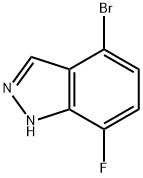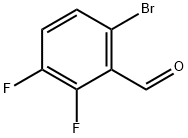
1H-Indazole, 4-broMo-7-fluoro- synthesis
- Product Name:1H-Indazole, 4-broMo-7-fluoro-
- CAS Number:1186334-63-3
- Molecular formula:C7H4BrFN2
- Molecular Weight:215.02

360576-04-1

1186334-63-3
Step 2: Synthesis of 4-bromo-7-fluoro-1H-indazole; 6-bromo-2,3-difluorobenzaldehyde (11.2 g) was dissolved in dimethoxyethane (51 mL). To this solution anhydrous hydrazine (51 mL) was slowly added, followed by heating the reaction mixture to reflux for 2.5 hours. The reaction progress was monitored by thin layer chromatography (TLC). Upon completion of the reaction, the solvent dimethoxyethane was evaporated by rotary evaporator. The remaining reaction mixture was cooled in an ice bath followed by addition of ice-water mixture. The precipitated white solid was collected by filtration and washed with cold water. The resulting solid was dissolved in dichloromethane, warmed and filtered. The filtrate was concentrated to dryness, dissolved again in dichloromethane, warmed up and filtered. 4-Bromo-7-fluoro-1H-indazole (6.19 g, white solid) was finally obtained in 32% yield. Mass spectral (MS) data: 215.0, 217.0 [M + H].

360576-04-1
137 suppliers
$9.00/1g

1186334-63-3
81 suppliers
$20.00/100mg
Yield:1186334-63-3 32%
Reaction Conditions:
with hydrazine in 1,2-dimethoxyethane; for 2.5 h;Product distribution / selectivity;Reflux;
Steps:
102.2
Step 2: 4-Bromo-7-fluoro-1 H-indazole; A 11.2 g portion of 6-bromo-2,3-difluoro-benzaldehyde was dissolved in 51 ml. of dimethoxyethane. To this was added 51 ml. of anhydrous hydrazine, followed by refluxing for2.5 hours; reaction monitored by thin layer chromatography (TLC). Dimethoxyethane was evaporated off and the remaining residue cooled in an ice bath. Ice was added and the resulting white solid filtered off, and washed with cold water. The solid was then warmed in dichloromethane and filtered. The filtrate was evaporated to dryness and warmed up in dichloromethane and filtered again. In total, 6.19 g of 4-bromo-7-fluoro-1 H-indazole was recovered as a white solid in 32% yield. MS: 215.0, 217.0 [M+H].
References:
WO2009/108838,2009,A1 Location in patent:Page/Page column 118

348-61-8
396 suppliers
$6.00/5g

1186334-63-3
81 suppliers
$20.00/100mg